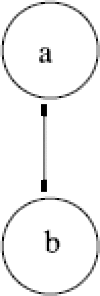Derived patterns in binocular rivalry networks
- PMID: 23657206
- PMCID: PMC3698087
- DOI: 10.1186/2190-8567-3-6
Derived patterns in binocular rivalry networks
Abstract
Binocular rivalry is the alternation in visual perception that can occur when the two eyes are presented with different images. Wilson proposed a class of neuronal network models that generalize rivalry to multiple competing patterns. The networks are assumed to have learned several patterns, and rivalry is identified with time periodic states that have periods of dominance of different patterns. Here, we show that these networks can also support patterns that were not learned, which we call derived. This is important because there is evidence for perception of derived patterns in the binocular rivalry experiments of Kovács, Papathomas, Yang, and Fehér. We construct modified Wilson networks for these experiments and use symmetry breaking to make predictions regarding states that a subject might perceive. Specifically, we modify the networks to include lateral coupling, which is inspired by the known structure of the primary visual cortex. The modified network models make expected the surprising outcomes observed in these experiments.
Figures













Similar articles
-
Network symmetry and binocular rivalry experiments.J Math Neurosci. 2014 May 7;4:12. doi: 10.1186/2190-8567-4-12. eCollection 2014. J Math Neurosci. 2014. PMID: 24872926 Free PMC article.
-
Symmetry of generalized rivalry network models determines patterns of interocular grouping in four-location binocular rivalry.J Neurophysiol. 2019 Nov 1;122(5):1989-1999. doi: 10.1152/jn.00438.2019. Epub 2019 Sep 18. J Neurophysiol. 2019. PMID: 31533006 Free PMC article.
-
Ring models of binocular rivalry and fusion.J Comput Neurosci. 2020 May;48(2):193-211. doi: 10.1007/s10827-020-00744-7. Epub 2020 May 3. J Comput Neurosci. 2020. PMID: 32363561
-
An astable multivibrator model of binocular rivalry.Perception. 1988;17(2):215-28. doi: 10.1068/p170215. Perception. 1988. PMID: 3067209 Review.
-
How does binocular rivalry emerge from cortical mechanisms of 3-D vision?Vision Res. 2008 Sep;48(21):2232-50. doi: 10.1016/j.visres.2008.06.024. Epub 2008 Aug 13. Vision Res. 2008. PMID: 18640145 Review.
Cited by
-
Network symmetry and binocular rivalry experiments.J Math Neurosci. 2014 May 7;4:12. doi: 10.1186/2190-8567-4-12. eCollection 2014. J Math Neurosci. 2014. PMID: 24872926 Free PMC article.
-
Symmetry of generalized rivalry network models determines patterns of interocular grouping in four-location binocular rivalry.J Neurophysiol. 2019 Nov 1;122(5):1989-1999. doi: 10.1152/jn.00438.2019. Epub 2019 Sep 18. J Neurophysiol. 2019. PMID: 31533006 Free PMC article.
-
A hierarchical model of perceptual multistability involving interocular grouping.J Comput Neurosci. 2020 May;48(2):177-192. doi: 10.1007/s10827-020-00743-8. Epub 2020 Apr 27. J Comput Neurosci. 2020. PMID: 32338341 Free PMC article.
References
-
- Wilson HR. In: Cortical Mechanisms of Vision. Jenkins M, Harris L, editor. Cambridge University Press, Cambridge; 2009. Requirements for conscious visual processing; pp. 399–417.
-
- Golubitsky M, Stewart I. Nonlinear dynamics of networks: the groupoid formalism. Bull Am Math Soc. 2006;3:305–364. doi: 10.1090/S0273-0979-06-01108-6. - DOI
-
- Golubitsky M, Stewart I. The Symmetry Perspective: From Equilibrium to Chaos in Phase Space and Physical Space. Birkhäuser, Basel; 2002.
-
- Golubitsky M, Stewart I, Schaeffer DG. Singularities and Groups in Bifurcation Theory: Volume II. Springer, New York; 1988. (Applied Mathematical Sciences 69).
LinkOut - more resources
Full Text Sources
Other Literature Sources
Miscellaneous

